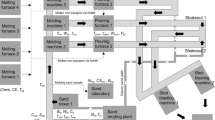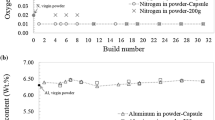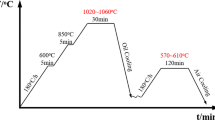Roll steel with a high chromium content (steel 45Kh5MF) is characterized by good hardenability, which provides an opportunity to significantly increase the durability of rolling-mill rolls. Here, the surface layer (working layer) of the rolls is strengthened thanks to the use of a heat treatment that forms a structure of lower bainite while blocking the pearlite transformation of austenite. At the same time, occurrence of the bainite transformation in high-chromium steel requires that the steel be kept in the narrow temperature range associated with this conversion (290–410°C) for a considerable length of time. Large rolls made of steel 45Kh5MF are quenched on a horizontal unit in two stages: intensive water-air cooling for 30–35 min (stage 1); cooling with compressed air for 4–5 h (Stage 2). Such quenching blocks the conversion of austenite to pearlite and ensures the formation of a satisfactorily developed bainitic structure. Efficient regimes for quenching and tempering large rolling-mill rolls were found by using integrated software that makes it possible to track the dynamics of the formation of temporary and residual stresses in rolls.







Similar content being viewed by others
References
N. P. Anufriev, S. V. Kamantsev, and M. V. Maisuradze, “Aspects of microstructure formation in steel 45Kh5MF during the production of rolls for hot rolling,” Stal, No. 10, 61–65 (2011).
N. P. Anufriev, S. V. Kamantsev, and M. V. Maisuradze, “Study of phase transformations and structural transformations in steel 45Kh5MF during continuous cooling,” Izv. Vyssh. Uchebn. Zaved. Chern. Metall., No. 6, 54–55 (2011).
R. I. Entin, Austenite Transformations in Steel, Metallurgizdat, Moscow (1960).
I. A. Borisov, L. F. Goland, and I. G. Zhigalkin, “Technology for water-air cooling in the heat treatment of large parts,” MiTOM, No. 12, 2–6 (1996).
A. N. Minkov, “Quenching of large parts with a controlled cooling rate,” Metallurg. Gornorud. Prom., No. 3, 88–91 (2013).
N. I. Vorob’ev, V. I. Antonov, V. B. Zakharov, et al., “Aspects of the cooling of quenched and tempered large forgings,” Stal, No. 3, 62–63 (2003).
I. Yu. Pyshmintsev, Yu. G. Eismondt, Yu. V. Yudin, et al., “Quenching of large forgings in a water–air mixture,” MiTOM, No. 3, 24–28 (2003).
B. Boley and J. Weiner, Theory of Thermal Stresses [Russian translation], Mir, Moscow (1964).
Ya. S. Podstrigach and Yu. M. Kolyano, General Thermomechanics, Naukova Dumka, Kiev (1976).
Yu. A. Samoilovich and R. G. Ushakova, “Thermal stresses in a steel ingot cooling in the ingot mold,” Thermophysics and Heat Exchange: Coll. Works of VNIIMT, Sverdlovsk (1969), No. 19, pp. 199–211.
Yu. A. Samoilovich and Z. K. Kabakov, “Accounting for the effect of relaxation in determining the thermal stresses in a casting solidifying within a certain temperature range,” Combustion. Heat Exchange. Heating of Metal: Coll. Works of VNIIMT, Metallurgiya, Moscow (1973), No. 24, pp. 100–113.
Yu. A. Samoilovich and Yu. A. Malevich, “Calculation of the thermal stresses in the solid skin of an ingot,” Izv. Vyssh. Uchebn. Zaved. Energetika, 74–78 (1988).
Yu. A. Samoilovich, The Microcomputer in the Solution of Problems on the Crystallization of Ingots, Metallurgiya, Moscow (1988).
Yu. A. Samoilovich, “Analysis of the thermal stress state of rails during bulk quenching,” Metallurg, No. 11, 65–72 (2011).
Yu. A. Samoilovich, “Improving the strength of railroad rails by isothermal quenching to lower bainite,” Stal, No. 4, 66–69 (2013).
E. I. Treiger and V. P. Prikhod’ko, Improving the Quality and Operational Reliability of Strip-Mill Rolls, Metallurgiya, Moscow (1988).
N. A. Kuklo, “Mechanism of the occurrence of delamination on the surface of rolls for cold rolling,” Stal, No. 6, 544–547 (1964).
V. P. Polukhin, V. A. Nikolaev, P. T. Shul’man, et al., Reliability and Durability of Rolls for Cold Rolling, Metallurgiya, Moscow (1971).
B. A. Brusilovskii and A. Ya. Shashko, “Mechanism of the occurrence of delamination on the surface of rolls for cold rolling,” Probl. Prochn., No. 2, 116–122 (2001).
Author information
Authors and Affiliations
Corresponding author
Additional information
Translated from Metallurg, No. 7, pp. 44–50, July, 2015.
Rights and permissions
About this article
Cite this article
Samoilovich, Y.A. Increasing the Service Life of Large Rolling-Mill Rolls by Using the Reserve Hardenability of the Steel. Metallurgist 59, 604–612 (2015). https://doi.org/10.1007/s11015-015-0146-x
Received:
Published:
Issue Date:
DOI: https://doi.org/10.1007/s11015-015-0146-x




